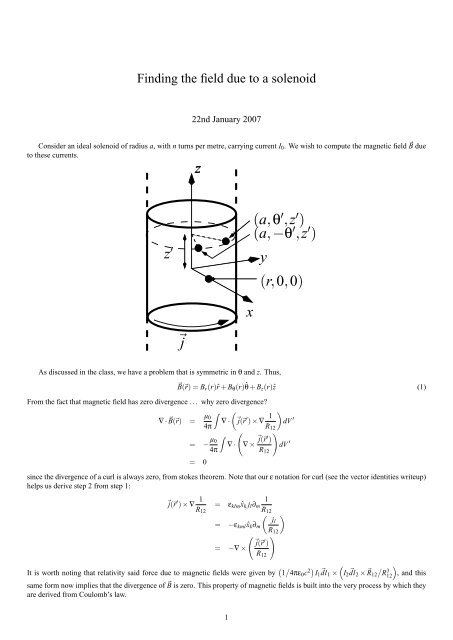Create successful ePaper yourself
Turn your PDF publications into a flip-book with our unique Google optimized e-Paper software.
So go<strong>in</strong>g back to Eq. 1, we obta<strong>in</strong>∇ ·⃗B = 1 r ∂ r (rB r ) + 1 r ∂ θB θ + ∂ z B z = 1 r ∂ r (rB r ) = 0Hence B r = B 0/r, which is not allowed if the doma<strong>in</strong> <strong>in</strong>cludes r = 0. i.e., Br ≡ 0. So,This magnetic field is obta<strong>in</strong>ed from⃗B(⃗r) = µ Z04π⃗B(⃗r) = B θ ˆθ + B z ẑ⃗j(⃗r ′ ) × ∇ 1R 12dV ′where ⃗j = I 0 n ˆθ ′ δ(r ′ − a). To make progress we go to the Vector Potential⃗A(⃗r) = µ Z0 ⃗ j(⃗r ′ )dV ′4π R 12S<strong>in</strong>ce the problem is symmetric <strong>in</strong> θ and z, we assume θ = 0 and z = 0. ⃗j(⃗r ′ ) is along ˆθ ′ , i.e., along − ˆxs<strong>in</strong>θ ′ + ŷcosθ ′ . Then,⃗A(r) = µ Z ∞ Z π0dz ′ adθ ′ I 0 n(−s<strong>in</strong>(θ ′ ) ˆx + cos(θ ′ )ŷ)√4π −∞ −π(x − acosθ ′ ) 2 + a 2 s<strong>in</strong> 2 θ ′ + z ′2= µ Z ∞ Z π0dz ′ adθ ′ I 0 ncos(θ ′ )ŷ√4π −∞ −π(x − acosθ ′ ) 2 + a 2 s<strong>in</strong> 2 θ ′ + z ′2= µ Z ∞ Z π04π I 0nŷ dz ′ adθ ′ cos(θ ′ )√−∞ −π(x − acosθ ′ ) 2 + a 2 s<strong>in</strong> 2 θ ′ + z ′2For θ = 0, ŷ is the same as ˆθ, s<strong>in</strong>ce ˆr is along ˆx. Thus, this shows us that ⃗A(r) is along ˆθ which is what we wanted to get out of thisexercise.We are now almost done. If ⃗A is along θ and depends only on r, its curl∣ ∣∣∣∣∣1ˆr rˆθ ẑr det ∂ r ∂ θ ∂ z0 rA θ 0 ∣ = 1 r ∂ r (rA θ )ẑ⃗B is purely along ẑ and depends only on r. We could use the above formulae to calculate it, but there is now an easier way. We useStoke’s theorem on a loop <strong>in</strong> the r − z plane, with unit length along z, and its two sides at r = 0 and at r.I⃗B · ⃗dl = B z (0) − B z (r)= µ 0 I enclThus, we immediately conclude (assum<strong>in</strong>g B z → 0 as r → ∞){µ0 nIB z (r) = 0 r < a0 r > aF<strong>in</strong>ite SolenoidWhat happens when the <strong>solenoid</strong> is not <strong>in</strong>f<strong>in</strong>itely long?∂ z is no longer zero, and so, B r can now be present:∇ ·⃗B = 1 r ∂ r (rB r ) + ∂ z B z = 0 (2)The arguments we used for ⃗A do not change; the only difference is that the limits <strong>in</strong> z are now f<strong>in</strong>ite. So we have⃗A(⃗r) = A θ (r,z)ˆθTak<strong>in</strong>g the curl yields⃗B(⃗r) = −ˆr∂ z A θ + ẑ 1 r ∂ r (rA θ )2
The divergence should automatically go to zero, as it does:( )11r ∂ r (−r∂ z A θ ) + ∂ zr ∂ r (rA θ )s<strong>in</strong>ce second partial derivitives commute.As a special case, consider r ≪ a. The expression for A θ becomes, for small x= 0A θ = µ Z L/2 Z π04π I 0nŷ dζ adθ ′ cos(θ ′ )√−L/2 −π(x − acosθ ′ ) 2 + a 2 s<strong>in</strong> 2 θ ′ + ζ 2≃ µ Z L/2−z Z π04π I 0nŷ dζ adθ ′ cos(θ ′ )√−L/2−z −π a 2 + ζ 2 − 2axcosθ ′≃ µ 04π I 0nŷ= µ 04 I 0nŷa 2 xZ L/2−z−L/2−zZ L/2−z−L/2−zZ πdζ adθ ′ cos(θ ′ ())√ 1 + axcos(θ′ )−π a 2 + ζ 2 a 2 + ζ 21dζ(a 2 + ζ 2 ) 3/2The <strong>in</strong>tegral is known <strong>in</strong> closed form (look up your favourite table of <strong>in</strong>tegrals. It is <strong>in</strong> all of them):Z βαdz(a 2 + z 2 ) 3/2 = β√β 2 + a − α√ 2 α 2 + a 2Apply<strong>in</strong>g the formula above, we obta<strong>in</strong> A θ and B z for the <strong>in</strong>f<strong>in</strong>ite case:a 2For the f<strong>in</strong>ite case, this becomesA θ = µ 02 I 0nrB z = 1 r ∂ r (rA θ ) = µ 02I 0 nr ∂ (r r2 ) = µ 0 nI 0Z L/2−zB z = µ 0 nI 0 dζ−L/2−z 2(a 2 + ζ 2 ) 3/2⎡L / 2 − z−L / ⎤2 − z= µ 0 nI 0⎣√ (L / )− √ ⎦2 (−L / )2 − z + a 2 2 2 − z + a 2a 2It is worth not<strong>in</strong>g that the fr<strong>in</strong>g<strong>in</strong>g fields of a <strong>solenoid</strong> do not fall off exponentially! Remember the case of the capacitor. There thefr<strong>in</strong>g<strong>in</strong>g fields fell off exponentially. The difference between the two cases is that for the capacitor, we specified voltage rather thanσ(x) on the plates. Here, we have specified the precise currents. When we do that, we do not allow for “self-consistent” currents,and the fr<strong>in</strong>g<strong>in</strong>g fields can penetrate a lot further.3
















